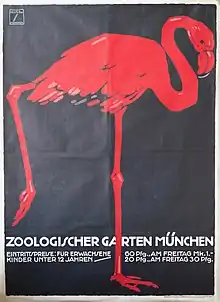Hellabrunn Zoo
Hellabrunn Zoo (or Tierpark Hellabrunn in German) is a 40 hectare (99 acre) zoological garden in the Bavarian capital of Munich. The zoo is situated on the right bank of the river Isar, in the southern part of Munich near the quarter of Thalkirchen.
 The elephant house was built in 1914 | |
| Date opened | 1 August 1911[1] |
|---|---|
| Location | Munich, Germany |
| Coordinates | 48°5′50″N 11°33′15″E |
| Land area | 40 ha (99 acres)[2] |
| No. of animals | 18,943 (2014)[3] |
| No. of species | 767 (2014)[3] |
| Annual visitors | 2,283,739 (2014)[3] |
| Memberships | EAZA,[4] WAZA[5] |
| Website | www.hellabrunn.de |
A high ratio of enclosures are cageless, relying upon moat features to keep the animals in place. The zoo was the first zoo in the world not organized by species, but also by geographical aspects. For example, the wood bison share their enclosure with prairie dogs.
In 2013, the zoo was ranked the fourth best zoo in Europe (up from 12th).[6][7] It focuses on conservation and captive breeding rare species such as the rare drill and silvery gibbons. Also gorillas, giraffes, elephants, wood bisons, elk and Arctic foxes were successfully bred in the zoo, which houses many species. It is one of the very few zoos that allows visitors to bring dogs.
Tierpark Hellabrunn is a member of the European Association of Zoos and Aquaria (EAZA) and the World Association of Zoos and Aquariums (WAZA) and participates in the European Endangered Species Programme (EEP).
History

On 25 February 1905 the Verein Zoologischer Garten München e.V. (Engl. Society of the Zoological Garden of Munich) was founded and the Hellabrunn area was chosen as the location for the zoo. The zoo was designed by architect Emanuel von Seidl, and opened to the public on 1 August 1911.[1]

[[Datei:Zoologischer Garten München.jpg|mini|Plakat von Ludwig Hohlwein (1912)]] In 1922, the zoo was closed due to the inflation in Germany. It was re-opened on May 23, 1928. It became the first Geo-Zoo in the world (animals were shown and kept with other animals of the same geographic region). It also engaged in controversial back-breeding to "recreate" extinct animals like Heck cattle (to mimic the Aurochs) and the Tarpan.[1]
During World War II, the zoo sustained extensive damage due to Allied air raids, but it was able to reopen in May 1945.
In 1970, a badly needed plan for the renovation of the zoo was drawn up.
Hellabrunn today
In 2014 it was home to 18,943 animals representing 767 species.[8]
The Tierpark Hellabrunn is very active in breeding, reintroduction and conservation projects.
Over 2.2 million people visited Hellabrunn in 2014.
As the groundwater level here is rather high and the water is of very good quality, the zoo can cover its needs for freshwater by using its own wells.
Attractions

- The elephant house: Constructed in 1914, renovated 2011-2016
- The new jungle house which houses gorillas, chimpanzees, Diana monkeys and American alligators
- Rare but very acrobatic silvery gibbons, spider monkeys, rare drills and colorful mandrills
- The new savannah house where visitors are separated only by a glass wall from the giraffes
- The aquarium with the piranha feeding
- "Dracula's villa" - bats fly around visitors
- Many other buildings like the "Polarium"
- Guided tours - especially when it's dark and there is no one else in the zoo
- Children's birthday parties
Notes
- "History of the Munich Zoo". tierpark-hellabrunn.de. Hellabrunn Zoo. Retrieved 27 November 2011.
- "Munich Zoo". zoo-infos.de. Zoo-Infos.de. Retrieved 23 November 2011.
- "Geschäfts-Bericht 2012" [2012 Annual Report] (PDF). tierpark-hellabrunn.de (in German). Hellabrunn Zoo. Retrieved 11 June 2014.
- "EAZA Member Zoos & Aquariums". eaza.net. EAZA. Retrieved 27 November 2011.
- "Zoos and Aquariums of the World". waza.org. WAZA. Retrieved 27 November 2011.
- "Zoo-Ranking" (in German). Tierpark Hellabrunn. 2013-08-29. Archived from the original on 2013-08-29. Retrieved 2016-10-31.
- Sheridan, Anthony (2011). Das A und O im Zoo Europas führende Zoologische Gärten 2010 - 2020. Münster, Westf: Schüling, K. ISBN 9783865231840.
- "2010 Annual Report" (PDF). tierpark-hellabrunn.de. Hellabrunn Zoo. Retrieved 27 November 2011.
External links
| Wikimedia Commons has media related to Tierpark Hellabrunn. |